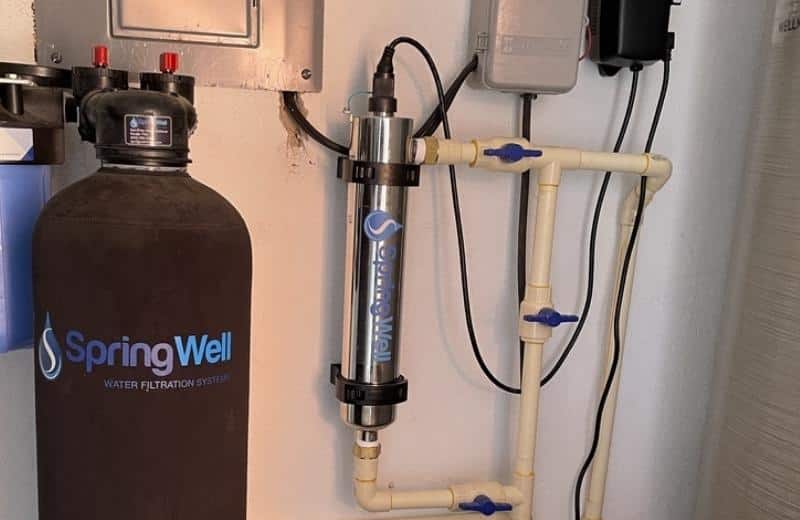Chlorine in drinking water tastes unpleasant and may have health effects, but the good news is that this chemical does evaporate from water – eventually.
In this article, we’ve answered the question, “How long does it take for chlorine gas to evaporate completely from water?”
📌 Key Takeaways:
- On average, it takes up to 110 hours, or 4 and a half days, for 2 PPM of chlorine to completely evaporate in water.
- Factors affecting the length of the chlorine evaporation process include the amount of water, the amount of chlorine in the water, the water storage method, and the water temperature.
- You can speed up the rate of chlorine evaporation by boiling the water, or remove chlorine instantly with an activated carbon water filter.
Table of Contents
📈 How Long For Chlorine To Evaporate From Water?
The average time it takes for 2 PPM of chlorine (the highest concentration of chlorine in potable drinking water) to evaporate is 110 hours, or 4 and a half days.
Your own personal tap water supply might become chlorine-free within 24 hours, or it might still contain traces of chlorine after 4-5 days.
There are a few factors that speed up or slow down the process of evaporation, which we’ve shared below.
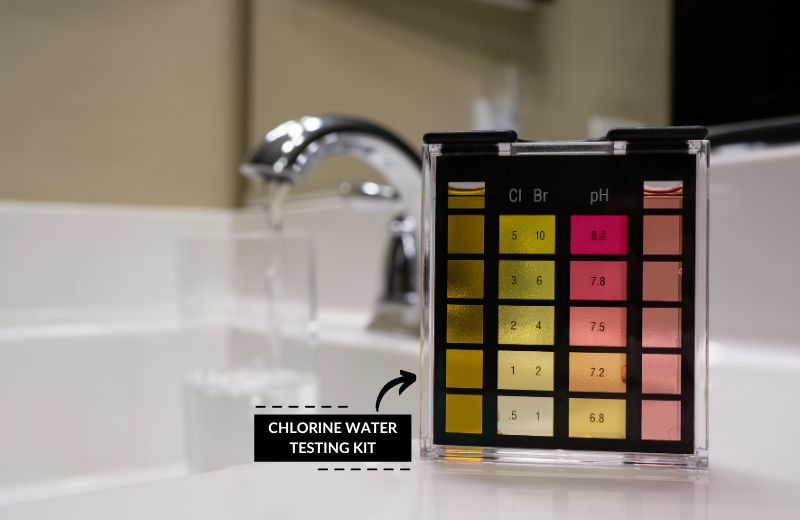
📊 Factors Affecting How Long It Takes For Chlorine To Evaporate
The Amount Of Chlorine
The concentration of chlorine in the water is one of the major factors that affect the rate of evaporation. The more chlorine the water contains, the faster it’ll evaporate.
Why? Because there’s a higher concentration of chlorine molecules in the water, which gives them a greater chance of escaping from the water’s surface. With that said, as the chlorine levels drop, there will be fewer molecules in the water, and the evaporation rate will gradually slow.
The Amount Of Water
The amount of tap water you want to evaporate chlorine from also affects the speed of evaporation.
The larger the volume of chlorinated water, the more chlorine molecules there are to remove. That means it’ll take longer to achieve chlorine-free water if you have, say, 10 gallons of water versus 1 gallon of water.
The Water Storage Method
The size and shape of the container holding the water also determines the speed of chlorine evaporation.
If you have a shallow, wide container, chlorine evaporation will be faster because the container has a larger surface area and chlorine molecules have more space to escape from the water. If the container is deep and slim, its surface area will be much smaller, and there’ll be less room for chlorine molecules to evaporate.
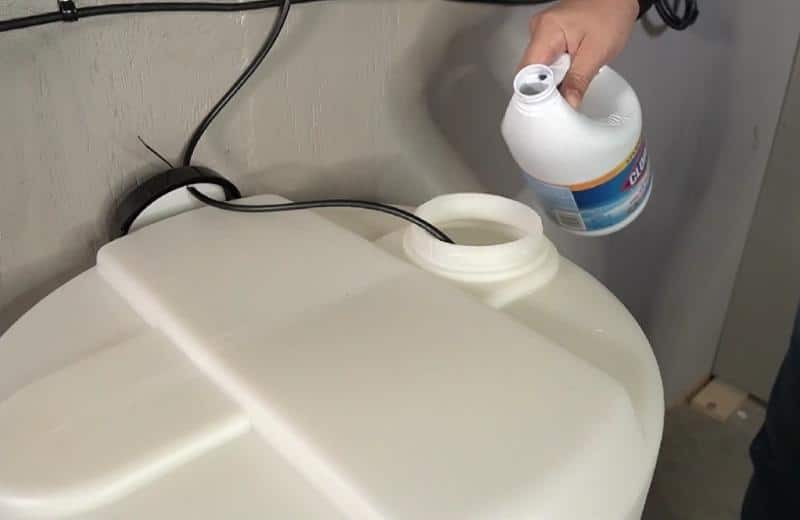
The Water Temperature
The water temperature is one of the primary factors that determines the rate of chlorine evaporation. The rate of evaporation increases as the temperature increases.
Why does this happen? Because the higher the temperature, the more energy the chlorine molecules have, which means they can escape from the water at a faster rate.
The Humidity
In addition to temperature, the humidity of the air that chlorinated tap water comes into contact with affects the rate of chlorine evaporation.
More humid air has a higher concentration of water molecules, which means that chlorine molecules have a more difficult job dissipating from the water. Because of this, the chlorine evaporation rate is generally faster in dry conditions than it is in humid conditions.
The Air Flow
Air flow is the final factor that can influence the rate of chlorine evaporation. If the water is stored in a location with moving air (e.g. a breeze from a fan or the wind), the evaporated chlorine molecules can be carried away at a faster rate.
That means, if you’re evaporating chlorine from water outside, you’ll probably eliminate chlorine faster than you would indoors.
🆚 Chlorine Vs Chloramine Evaporation Time
Both chlorine and chloramine are commonly used by municipalities to disinfect tap water, ensuring clean and drinkable water in our homes.
There are a few differences between chlorine and chloramine and their evaporation rate in tap water.
While both chlorine and chloramine are used for the same purpose, they have different stabilities in water. Chlorine, as a highly reactive chemical, evaporates more quickly in water, while chloramine, which is more stable, takes longer to evaporate.
Plus, chloramine gradually disinfects the water over a longer period, which means it remains effective for longer than chlorine. That’s good reassurance that your water is contaminant-free, but not so great if you want to evaporate it from your water.
⏭ How To Speed Up Chlorine Evaporation
You know that if you let your tap water sit out for long enough, the chlorine will evaporate eventually. But what if you don’t want to wait that long? How can you speed up chlorine evaporation?
There are a few ways that you do this, which we’ve shared below.
Boiling Water
We know that volatile chlorine evaporates at a faster rate at higher temperatures, so bringing water’s temperature up by boiling can help to speed up the rate of evaporation. It takes around 15 minutes for chlorine to dissipate completely from tap water with boiling, depending on the volume of water and its chlorine content.
If you have too much water to boil or you don’t have facilities for boiling water, you can still speed up the rate of evaporation by placing the water container in a warmer location or using a heater to raise the water’s temperature.
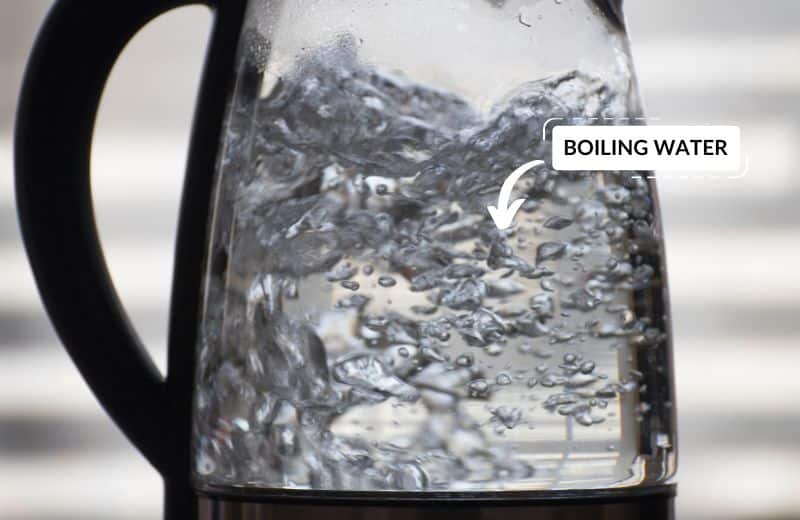
Increase The Storage Container’s Area
If you have the luxury of options, be smart about how you store your chlorinated tap water. Molecules of chlorine evaporate fastest when they have a big surface area to escape from.
So, store your water in a wide, shallow container with a larger surface area. This will allow the chlorine molecules to escape at a faster rate.
Increase Air Flow Around The Water
Moving air carries away evaporated chlorine particles and helps speed up the rate of evaporation, so try increasing the air flow around the water container.
You can do this by storing the container in a room with a fan or placing the container in an outdoor location with a natural breeze. Make sure water stored outside is screened from bugs and other debris.
📤 How to Remove Chlorine From Water Quickly
Waiting for chlorine to dissipate from tap water, even using the methods above to speed up the evaporation rate, is a long job. You might prefer to remove chlorine with a quicker solution.
The fastest methods of removing chlorine from water are with a carbon filter, a UV light source, or ascorbic acid.
Related: Recommended water filters for chlorine reduction
Use An Activated Carbon Filter
One of the best methods of removing chlorine from tap water is to use a carbon filter.
Activated carbon can remove chlorine molecules out of water with a sponge-like process called adsorption. A carbon filter removes around 95% of free chlorine from drinking water.
As well as removing chlorine, activated carbon filters also remove some pesticides, herbicides, disinfection byproducts, volatile organic compounds, and several other harmful chemicals.
You can buy numerous carbon filters for various use points, including carbon water pitchers, faucet filters, under-sink filters, and countertop filters. You can also buy carbon filters for use in a fish tank to protect freshwater fish from this chemical.
👨🔧 You can also make your own water filter with activated charcoal carbon to remove chlorine if you want to keep costs low.
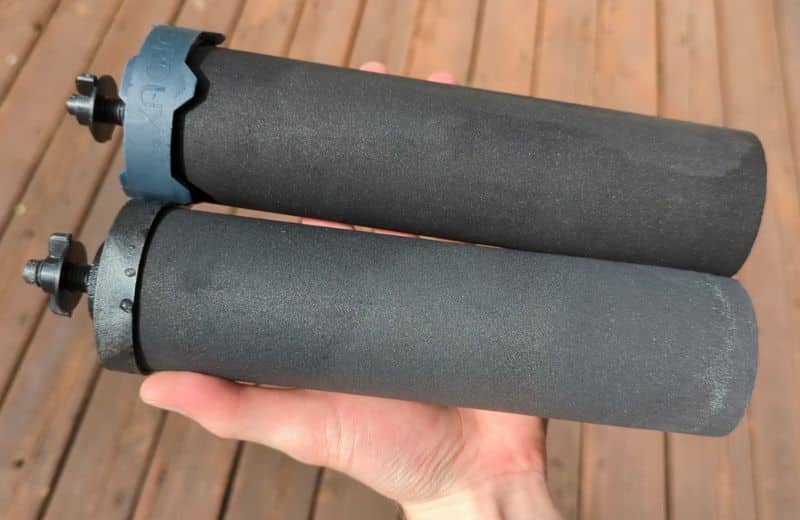
Use Ultraviolet Light (UV Light)
UV light is another highly effective method of removing chlorine from tap water.
The primary purpose of an ultraviolet light system is to kill bacteria, viruses, and other microorganisms found in some tap water supplies. But medium-pressure UV rays with a radiant energy density of around 600 millimeters can also remove chlorine by transforming it into chloride ions and/or hydrochloric acid.
A UV light can be installed at water’s point of entry into your home and should treat all the chlorine in your water supply.
👨🔧 Check out WFG’s UV water filter recommendations in 2024
Use Ascorbic Acid
Finally, ascorbic acid is a cheap, quick, chemical-free, and effective way to reduce the chlorine level in a tap water supply.
Ascorbic acid precipitates chlorine out of the surface of the water. You need to add about 1 teaspoon of ascorbic acid to 1 pint of water to effectively get rid of chlorine.
Note that ascorbic acid is a weak acid, so it might reduce your water’s pH slightly.
❔ Chlorine Evaporation In Water: FAQ
How is chlorine used in water treatment?
Chlorine is commonly used as a disinfectant to kill bacteria and other harmful microorganisms in drinking water. It’s usually added to water in the form of chlorine gas, liquid bleach, or a solution called calcium hypochlorite.
How long does it take for chlorine to evaporate from water?
It takes anywhere from a few hours to several days for most chlorine to evaporate from a chlorinated drinking water supply. The rate that molecules of chlorine evaporate from water depends on factors including the temperature, humidity, and air flow in the environment.
Can I speed up the evaporation process for chlorine in water?
Yes – to speed up the evaporation of chlorine from water, you can try increasing the air flow around the water, such as by using a fan or placing the water in a location with a breeze. You can also try raising the water’s temperature, as chlorine tends to evaporate more quickly at higher temperatures, and putting the water in a container with a bigger surface area.
Does letting water sit out remove chlorine?
Yes, letting water sit out removes chlorine, but it’s a slow process. In a standard pitcher jug at room temperature, it takes up to 110 hours, or 4 and a half days, for 2 PPM of chlorine to completely evaporate.
How long does it take for chlorine to evaporate from a 5 gallon bucket?
It takes 4-5 days for chlorine to completely evaporate from a 5-gallon bucket of water. You can speed up the rate of evaporation by boiling the water, increasing air flow around the bucket, or pouring the water into several containers with bigger surface areas.

